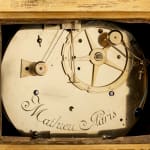Claude Mathieu
Literature
Winthrop Kellogg Edey, "French Clocks", 1967, p. 67, illustrating a comparable but more elaborate clock by Mathieu which, being the property of the late George Field, was sold at Christie's London, 12th June 1893, lot 80 for 199 guineas, 10 shillings to Wertheimer and later entered the Greenberg Collection, New York. Jean-Dominique Augarde, "Les Ouvriers du Temps", 1996, p. 205, pl. 167, illustrating a more elaborate version of the latter by Claude Mathieu with additional flanking figures of Study and Geography upon a green marble base, which was delivered for the furnishings of the Michel Palace built by Emperor Paul I at St Petersburg in 1798 and is now in the Great Palace of the Kremlin in Moscow. Pierre Kjellberg, "Encyclopédie de la Pendule Française du Moyen Age au XXe Siècle", 1997, p. 284, pl. A, illustrating this clock and noting that another identical clock is signed by the clockmaker Henry Voisin à Paris.
An extremely fine Louis XVI gilt bronze striking pendule à cercles tournants by Claude Mathieu of fourteen duration signed on the movement Mathieu à Paris, the upper part of the clock shaped as a covered urn set with two revolving chapter rings each with rectangular white enamel disks, those above marked with Arabic numerals for the five minute intervals and those below with Roman hour numerals, the time being indicated by the tip of an upward curled tail of a salamander. The chapter rings revolving by means of an indirect bevel gear system to the going barrel movement below with anchor escapement and count wheel strike on a bell within the base. The magnificent fluted urn-shaped case with fluting and a band of arrow heads surmounted by a domed lid and a gadrooned and berried laurel leaf finial above scrolled handles festooned with fruit-laden foliate swags, the fluted sconce base supported on a rectangular pedestal with chamfered corners set with fluted pilasters and ornamented by rams' heads to either side, draped with ribbon-tied berried laurel leaf swags that fall across the front which is further ornamented by four rosettes in each corner, above a shaped foliate band on a conformingly shaped stepped base
Paris, date circa 1775
Height 53 cm, width 22 cm, depth 19 cm.
Throughout the eighteenth century Parisian clockmakers created an array of ingeniously designed clocks such as this for the royalty, aristocracy and other extremely wealthy clients. Here, instead of a more usual circular dial the time is indicated via two revolving horizontally aligned chapter rings. In keeping with the Louis XVI taste, the case is inspired by Greco-Roman antiquity, taking as its main form a classical covered urn upon a plinth which is ornamented with such architectural motifs as laurel leaf swags, rams' heads and fluted pilasters.
One of the leading exponents of this type of clock was Claude Mathieu (b.1722 d. after 1812), who made the present example as well as other similar clocks with revolving rings. Some of those included an additional astronomical dial and were housed in equally elaborate cases of which the finest example by Mathieu was housed in a case featuring allegories of Study and Geography, which, was delivered with the furnishing of the Michel Palace built by the Emperor Paul I in Saint Petersburg in 1798. In addition to the above another comparable clock from the collection of Charles de Bestegui, Château du Groussay, was sold by Sotheby's 3rd June 1999, lot 868. A further clock with a replaced plain dial by Droz was sold from Le Pavillon Chougny, Christie's London, 9th December 2004, lot 374.
Claude Mathieu was born at Troyes and is known as l'Ainé to distinguish him from his younger brother Edme, known as Mathieu le Jeune (d. after 1806) who also worked as a clockmaker. They were the sons of Claude, who worked as a gardener and Jeanne Mathieu née Douine. Mathieu l'Ainé, who married Jeanne-Marguerite Philipart and subsequently Anne Bogotte, initially worked as a compagnon in Paris in 1743. Just over a decade later, on 31st July 1754, he was received as a Parisian maître horloger by a decree of 25th June that year exempting him from lack of apprenticeship. By 1754 he was established at rue Neuve des Capucines but by 1757 he was working from rue Saint-Honoré opposite the Hôtel de Noailles. Such was his standing that he was made a member of the jury presiding over the matters of the new time system in 1793. His business was carried on by his son-in-law B. L. Petit. Like his brother, Claude Mathieu used clock cases by P. Delacroix in addition to M. Poisson as well as watch cases by J. de La Feuille and counted among his distinguished clientele the comte de La Marck.



